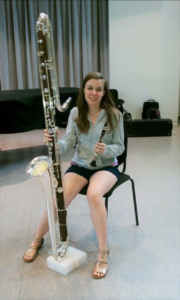So You Want to Play an Auxiliary Clarinet?

One of the great things about the clarinet is that it has quite the extended family. From the mighty contra-bass clarinet to the wailing E-flat clarinet, there is a veritable orchestra of clarinets at our disposal.
Although each clarinet uses basically the same fingerings and similar fundamentals, each auxiliary clarinet presents its own unique challenges. Here’s everything you need to known about playing an auxiliary clarinet:
Why should you play an auxiliary clarinet?
- To become more marketable. More clarinets = more gigs.
- Your band director or ensemble conductor asked you to double or switch.
- Most importantly: because clarinets are cool and you want to learn an auxiliary clarinet!
Which auxiliary clarinet should you play?
The two most common auxiliary clarinets are the bass clarinet and E-flat clarinet. Other auxiliaries include alto, basset horn (not to be confused with the basset clarinet, which is an A clarinet with an extended range to written low C) contra-alto, and contra-bass clarinets. There are many more auxiliary clarinets, such as the soprano clarinet in C, piccolo clarinet in D, and even the piccolissimo clarinet in Ab, pictured above. Choosing the right auxiliary clarinet is a personal choice, and there are no better or worse clarinets to play (and although undeserved, the alto clarinet remains the black sheep of the clarinet family and is the brunt of many jokes).
Before you choose, keep in mind:
- Your hand size. Generally speaking, smaller hands are better suited for smaller clarinets, and larger hands are better suited for larger clarinets. Make sure that your hands and fingers can easily reach and easily manipulate all of the keys.
- The instrument’s weight/your daily commute. Contra clarinet might sound appealing at first, but it’s not so fun when you have to lug that beast around to and from gigs.
- The instrumentation needs of your ensemble. If your group needs an alto clarinetist, why not give it a go?
- Performing opportunities in your area. While you shouldn’t choose an instrument purely based on performance opportunities, having the skill set to play auxiliary clarinets can make you more marketable than clarinetists who just play the B-flat clarinet.
Renting vs. Buying
Auxiliary clarinets aren’t cheap! Because auxiliary clarinets are not as frequently used or produced as the standard B-flat clarinet, the prices are generally higher.
If you are just learning an auxiliary clarinet for school or leisurely playing in local groups, renting is probably best for you. Inquire about rental policies at local music stores, or see if you can borrow an instrument from a school or clarinetist in the area.
If you are planning to specialize in a particular auxiliary clarinet, buying is your best bet. If you plan on taking auditions or perform professionally, you should save your money to buy a professional auxiliary clarinet. Investing in a quality instrument will pay dividends in your career. I’ve listed my favorite professional auxiliary clarinets later in this post.
Using school-owned instruments
School-owned instruments face a lot of abuse – they’re often shared among multiple players and are usually more affordable beginner or intermediate models. Here’s how to make the best out of using school-owned clarinets:
- Treat the instrument as if it were your own. Just because you aren’t paying the bill doesn’t mean that you should have lower instrument care standards.
- Keep the instrument in proper working condition. If you notice a problem, tell your band director or clarinet professor immediately so that it can be repaired.
- Use your own mouthpiece, ligature, and reeds. Even if you share the instrument with other players, there’s no reason you can’t use your own mouthpiece, ligature, and reed! Besides avoiding the spread of germs, personalizing these pieces of equipment will result in a better sound and response. Just be sure you don’t leave your equipment in the case where it can get lost or stolen!
Customizing your auxiliary clarinet
Congratulations, you’ve chosen the right auxiliary clarinet for you! You’ve either bought a quality instrument or found one to borrow or rent for the time being. Now comes the fun part – customizing your auxiliary clarinet! Here’s how to turn an auxiliary clarinet into an awe-xiliary clarinet (sorry, I tried!):
- Don’t use the stock mouthpiece. This advice applies to all members of the clarinet family, but especially auxiliaries. A great mouthpiece can make a huge difference in both comfort and sound quality!
- Find the reed that’s right for you. Just like on the B-flat clarinet, you have to find the right brand, model, cut, and strength of reed that works for you. No matter which clarinet I’m playing, my reed of choice is always Vandoren. Don’t forget: Larger or smaller reeds might not fit in your normal reed case, so make sure you have a reed case which can accommodate your new reeds.
- Work with an expert clarinet repair technician. As clarinets increase or decrease in size, tuning problems become more apparent. If you notice any especially egregious notes, talk to a clarinet specialist to see if they can adjust key height or anything else to help improve your tuning. Note: Make sure you understand the difference between instrument specific tuning problems and general clarinet tuning problems before you make any adjustments (i.e. high C# generally runs sharp on most clarinets vs. low F being really flat on your auxiliary clarinet).
- Get a new swab. True story: When I first played E-flat clarinet in high school, I didn’t even consider the fact that it would need a smaller swab! I learned that lesson the hard way when my swab got stuck inside my E-flat clarinet.
Practicing an auxiliary clarinet
I know you’re probably excited to dive right in to new and unexplored repertoire territory, so here are my favorite tips to become acquainted with an auxiliary clarinet:
- Practice long tones with a tuner. Each clarinet has its own tuning tendencies, so as you get to know your new instrument, make note of yours.
- Scales, scales, scales. Scales are a wonderful way for your hands and fingers to become acquainted with the size difference of your new clarinet.
- Experiment with small embouchure adjustments. Mouthpiece size and angle of entry might call for slightly modified embouchures. If you aren’t achieving your desired sound, consider trying minor embouchure adjustments, such as taking in more mouthpiece or slightly relaxing the embouchure for larger clarinets.
- Listen to auxiliary clarinet specialists. There are some incredibly talented auxiliary clarinet performers around the world. I’ve listed a few of my favorites below.
- Practice transposition. Just when you started feeling comfortable with B-flat transposition, you’ve got to learn some new transposition! Historically, clarinets have been made in every key except F#, and C#, so brush up on your transposition!
Favorite auxiliary clarinet resources & notable performers
(performers listed alphabetically by surname)
E-flat clarinet
- Resources: Orchestral Studies for the E-Flat Clarinet by Peter Hadcock
- Performers: Jacques Merrer, Peter Simenauer, John Bruce Yeh
Bass clarinet
- Resources: Symphonic Repertoire for the Bass Clarinet by Michael Drapkin
- Performers: Sauro Berti, Eric Dolphy, Michael Lowenstern, André Moisan, Alcides Rodriguez, Harry Sparnaay, Dennis Smylie, Amy Zoloto
Contra clarinet
- Resources: Music for Contrabass Clarinet by Sarah Watts
- Performers: Cyrille Mercadier, Sarah Watts
Jack of all trades: While most people are lucky to master just one auxiliary clarinet, some people like my friend Keith Northover can manage a zoo of auxiliary clarinets!
Favorite auxiliary clarinet models
Choosing the right instrument is a highly personal choice, so be sure to play test as many different models as possible before making your final selection. I mostly play the E-flat clarinet, but I have also listed my favorite bass clarinet models as well. As a general rule, I avoid playing clarinets taller than I am, so I’ve refrained from listing contra clarinets.
E-flat clarinet: Buffet Crampon RC Prestige
Bass clarinet: Buffet Crampon 1193 low C Prestige; Selmer Privilege low C
Good luck on your auxiliary clarinet journey, and happy practicing!
